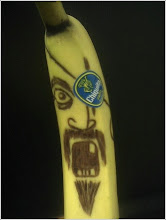
A pinhole camera is a very simple camera with no lens and a single very small aperture. Simply explained, it is a light-proof box with a small hole in one side. Light from a scene passes through this single point and projects an inverted image on the opposite side of the box. Cameras using small apertures and the human eye in bright light both act like a pinhole camera.
The smaller the hole, the sharper the image, but the dimmer the projected image. Optimally, the size of the aperture should be 1/100 or less of the distance between it and the screen.
A pinhole camera's shutter is usually manually operated because of the lengthy exposure times, and consists of a flap of some light-proof material to cover and uncover the pinhole. Typical exposures range from 5 seconds to hours and sometimes days.

A common use of the pinhole camera is to capture the movement of the sun over a long period of time. This type of photography is called Solargraphy.
The image may be projected onto a translucent screen for real-time viewing (popular for observing solar eclipses), or can expose film or a charge coupled device (CCD). Pinhole cameras with CCDs are often used for surveillance because they are difficult to detect.
A pinhole camera canbe made from a light-tight can or box with a black interior and a tiny hole in the center of one end. See illustrations below. You can design it to accept roll or sheet film. The two ends of the camera are parallel. The end opposite the pinhole is flat so that the film is held in a flat plane. The pinhole has a cover to prevent light from entering the camera when you aren't taking a picture.
How to make your own pinhole camera
in order to make your own pinhole camera you will need:
- a light proof container - a tin, cardboard box etc
- some black card/black paint
- tin foil
- tape
- a pin
- photography
My pinhole camera
when i made my own pinhole camera i used an old shoe box, i painted the inside and lid of the box black, making it light proof. i then cut a 2cm hole in the centre of the box, this is the aperture. an aperture is a hole in a camera which allows the light through to shine an inverted image through onto the film or in this case the photograpghic paper. i then made a shutter out of cardboard to cover up the hole when i do not want a photo to be taken, this will make sure that no light is exposed too the paper at inappropriate times.
i then had to measure the focal lenght of my camera, this is the distance between the hole and the photographic paper inside the camera. finding out my focal length helped me get an idea of how long to expose my camera to light. i also took some light readings and using these and my f-stop we estimated how long i wo9uld have to expose my camera to sunlight. for me i had to wait 15mins inside and 20 seconds outside.
i then took my pictures. this involved me loading the photographic paperinto my camera in a dark room, this was so that no sunlight would react with my photogra phic paper. i then chose suitable locations from taking my pictures. the first picture i took was outside, i placed my pinhole camera in the view of some trees. this photo, i think was the most successful of my three photographs, as it turned out the clearest.
phic paper. i then chose suitable locations from taking my pictures. the first picture i took was outside, i placed my pinhole camera in the view of some trees. this photo, i think was the most successful of my three photographs, as it turned out the clearest.
For my second photograph i chose a view of the inside of the atrium. When i loaded the photographic paper for my second photograph, i screwed u p two balls of paper and placed them on either side of my box, this would produce a concave effect. i then went to find a suitable location. i placed my camera on one of the tables and pointed it across the hall. i then opened my shutter and waited 15mins for my photo to produce. when the photo was ready, i closed the shutter on my camera and took it back to the dark room where i soaked and dryed my photo.
p two balls of paper and placed them on either side of my box, this would produce a concave effect. i then went to find a suitable location. i placed my camera on one of the tables and pointed it across the hall. i then opened my shutter and waited 15mins for my photo to produce. when the photo was ready, i closed the shutter on my camera and took it back to the dark room where i soaked and dryed my photo.

my final shot was of the inside of the atrium again, this time from the other side of the hall.
once i had taken all of my photographs. i used the scanner to upload them onto the computer and edited them using Adobe Photoshop Cs4. when i was editing my photos i adjusted the contrast and brightness to achieve the clearest images. i was pleased and impressed that all three of my images turned out as clear as they did.
my first image after editing.

my 2nd image after editing

my 3rd image after editing


An excellent blog entry Gareth - full of theoretical and practical detail. Your final images are also really creative and demonstrate a clear appreciation of the techniques involved in pinhole image making - well done, a great start to the course.
ReplyDelete